[English] 日本語
 Yorodumi
Yorodumi- PDB-3j45: Structure of a non-translocating SecY protein channel with the 70... -
+ Open data
Open data
- Basic information
Basic information
| Entry | Database: PDB / ID: 3j45 | ||||||
|---|---|---|---|---|---|---|---|
| Title | Structure of a non-translocating SecY protein channel with the 70S ribosome | ||||||
 Components Components |
| ||||||
 Keywords Keywords | RIBOSOME/PROTEIN TRANSPORT / 70S /  SECYEG / protein translocation channel / RIBOSOME-PROTEIN TRANSPORT complex SECYEG / protein translocation channel / RIBOSOME-PROTEIN TRANSPORT complex | ||||||
| Function / homology |  Function and homology information Function and homology informationprotein insertion into membrane from inner side / cell envelope Sec protein transport complex / protein transport by the Sec complex /  intracellular protein transmembrane transport / protein-transporting ATPase activity / SRP-dependent cotranslational protein targeting to membrane, translocation / intracellular protein transmembrane transport / protein-transporting ATPase activity / SRP-dependent cotranslational protein targeting to membrane, translocation /  signal sequence binding / protein transmembrane transporter activity / signal sequence binding / protein transmembrane transporter activity /  protein secretion / protein secretion /  intracellular protein transport ...protein insertion into membrane from inner side / cell envelope Sec protein transport complex / protein transport by the Sec complex / intracellular protein transport ...protein insertion into membrane from inner side / cell envelope Sec protein transport complex / protein transport by the Sec complex /  intracellular protein transmembrane transport / protein-transporting ATPase activity / SRP-dependent cotranslational protein targeting to membrane, translocation / intracellular protein transmembrane transport / protein-transporting ATPase activity / SRP-dependent cotranslational protein targeting to membrane, translocation /  signal sequence binding / protein transmembrane transporter activity / signal sequence binding / protein transmembrane transporter activity /  protein secretion / protein secretion /  intracellular protein transport / intracellular protein transport /  ribosomal large subunit assembly / large ribosomal subunit rRNA binding / cytoplasmic translation / cytosolic large ribosomal subunit / ribosomal large subunit assembly / large ribosomal subunit rRNA binding / cytoplasmic translation / cytosolic large ribosomal subunit /  rRNA binding / structural constituent of ribosome / rRNA binding / structural constituent of ribosome /  translation / translation /  membrane / membrane /  plasma membrane / plasma membrane /  cytosol / cytosol /  cytoplasm cytoplasmSimilarity search - Function | ||||||
| Biological species |   Escherichia coli (E. coli) Escherichia coli (E. coli) | ||||||
| Method |  ELECTRON MICROSCOPY / ELECTRON MICROSCOPY /  single particle reconstruction / single particle reconstruction /  cryo EM / Resolution: 9.5 Å cryo EM / Resolution: 9.5 Å | ||||||
 Authors Authors | Menetret, J.F. / Park, E. / Gumbart, J.C. / Ludtke, S.J. / Li, W. / Whynot, A. / Rapoport, T.A. / Akey, C.W. | ||||||
 Citation Citation |  Journal: Nature / Year: 2014 Journal: Nature / Year: 2014Title: Structure of the SecY channel during initiation of protein translocation. Authors: Eunyong Park / Jean-François Ménétret / James C Gumbart / Steven J Ludtke / Weikai Li / Andrew Whynot / Tom A Rapoport / Christopher W Akey /  Abstract: Many secretory proteins are targeted by signal sequences to a protein-conducting channel, formed by prokaryotic SecY or eukaryotic Sec61 complexes, and are translocated across the membrane during ...Many secretory proteins are targeted by signal sequences to a protein-conducting channel, formed by prokaryotic SecY or eukaryotic Sec61 complexes, and are translocated across the membrane during their synthesis. Crystal structures of the inactive channel show that the SecY subunit of the heterotrimeric complex consists of two halves that form an hourglass-shaped pore with a constriction in the middle of the membrane and a lateral gate that faces the lipid phase. The closed channel has an empty cytoplasmic funnel and an extracellular funnel that is filled with a small helical domain, called the plug. During initiation of translocation, a ribosome-nascent chain complex binds to the SecY (or Sec61) complex, resulting in insertion of the nascent chain. However, the mechanism of channel opening during translocation is unclear. Here we have addressed this question by determining structures of inactive and active ribosome-channel complexes with cryo-electron microscopy. Non-translating ribosome-SecY channel complexes derived from Methanocaldococcus jannaschii or Escherichia coli show the channel in its closed state, and indicate that ribosome binding per se causes only minor changes. The structure of an active E. coli ribosome-channel complex demonstrates that the nascent chain opens the channel, causing mostly rigid body movements of the amino- and carboxy-terminal halves of SecY. In this early translocation intermediate, the polypeptide inserts as a loop into the SecY channel with the hydrophobic signal sequence intercalated into the open lateral gate. The nascent chain also forms a loop on the cytoplasmic surface of SecY rather than entering the channel directly. | ||||||
| History |
|
- Structure visualization
Structure visualization
| Movie |
 Movie viewer Movie viewer |
|---|---|
| Structure viewer | Molecule:  Molmil Molmil Jmol/JSmol Jmol/JSmol |
- Downloads & links
Downloads & links
- Download
Download
| PDBx/mmCIF format |  3j45.cif.gz 3j45.cif.gz | 323.8 KB | Display |  PDBx/mmCIF format PDBx/mmCIF format |
|---|---|---|---|---|
| PDB format |  pdb3j45.ent.gz pdb3j45.ent.gz | 216.2 KB | Display |  PDB format PDB format |
| PDBx/mmJSON format |  3j45.json.gz 3j45.json.gz | Tree view |  PDBx/mmJSON format PDBx/mmJSON format | |
| Others |  Other downloads Other downloads |
-Validation report
| Arichive directory |  https://data.pdbj.org/pub/pdb/validation_reports/j4/3j45 https://data.pdbj.org/pub/pdb/validation_reports/j4/3j45 ftp://data.pdbj.org/pub/pdb/validation_reports/j4/3j45 ftp://data.pdbj.org/pub/pdb/validation_reports/j4/3j45 | HTTPS FTP |
|---|
-Related structure data
| Related structure data |  5692MC  5691C  5693C  3j46C  4v4nC M: map data used to model this data C: citing same article ( |
|---|---|
| Similar structure data |
- Links
Links
- Assembly
Assembly
| Deposited unit | 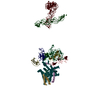
|
|---|---|
| 1 |
|
- Components
Components
-Protein , 3 types, 3 molecules yEG
| #1: Protein | Mass: 47643.305 Da / Num. of mol.: 1 Source method: isolated from a genetically manipulated source Source: (gene. exp.)   Escherichia coli (E. coli) / Gene: secY / Plasmid: pBAD-EhisYG / Production host: Escherichia coli (E. coli) / Gene: secY / Plasmid: pBAD-EhisYG / Production host:   Escherichia coli (E. coli) / Strain (production host): C43(DE3) / References: UniProt: P0AGA2 Escherichia coli (E. coli) / Strain (production host): C43(DE3) / References: UniProt: P0AGA2 |
|---|---|
| #2: Protein | Mass: 6123.306 Da / Num. of mol.: 1 Source method: isolated from a genetically manipulated source Source: (gene. exp.)   Escherichia coli (E. coli) / Gene: secE / Plasmid: pBAD-EhisYG / Production host: Escherichia coli (E. coli) / Gene: secE / Plasmid: pBAD-EhisYG / Production host:   Escherichia coli (E. coli) / Strain (production host): C43(DE3) / References: UniProt: P0AG96 Escherichia coli (E. coli) / Strain (production host): C43(DE3) / References: UniProt: P0AG96 |
| #3: Protein | Mass: 6542.755 Da / Num. of mol.: 1 Source method: isolated from a genetically manipulated source Source: (gene. exp.)   Escherichia coli (E. coli) / Gene: secG / Plasmid: pBAD-EhisYG / Production host: Escherichia coli (E. coli) / Gene: secG / Plasmid: pBAD-EhisYG / Production host:   Escherichia coli (E. coli) / Strain (production host): C43(DE3) / References: UniProt: P0AG99 Escherichia coli (E. coli) / Strain (production host): C43(DE3) / References: UniProt: P0AG99 |
-50S ribosomal protein ... , 3 types, 3 molecules TUY
| #4: Protein |  Mass: 11222.160 Da / Num. of mol.: 1 / Source method: isolated from a natural source / Source: (natural)   Escherichia coli (E. coli) / Strain: MRE600 / References: UniProt: P0ADZ0 Escherichia coli (E. coli) / Strain: MRE600 / References: UniProt: P0ADZ0 |
|---|---|
| #5: Protein |  Mass: 11208.054 Da / Num. of mol.: 1 / Source method: isolated from a natural source / Source: (natural)   Escherichia coli (E. coli) / Strain: MRE600 / References: UniProt: P60624 Escherichia coli (E. coli) / Strain: MRE600 / References: UniProt: P60624 |
| #6: Protein |  Mass: 7286.464 Da / Num. of mol.: 1 / Source method: isolated from a natural source / Source: (natural)   Escherichia coli (E. coli) / Strain: MRE600 / References: UniProt: P0A7M6 Escherichia coli (E. coli) / Strain: MRE600 / References: UniProt: P0A7M6 |
-23S ribosomal ... , 5 types, 5 molecules 12345
| #7: RNA chain |  Mass: 20350.104 Da / Num. of mol.: 1 / Fragment: helix 6 - helix 7 / Source method: isolated from a natural source / Source: (natural)   Escherichia coli (E. coli) / Strain: MRE600 Escherichia coli (E. coli) / Strain: MRE600 |
|---|---|
| #8: RNA chain |  Mass: 11661.961 Da / Num. of mol.: 1 / Fragment: helix 50 / Source method: isolated from a natural source / Source: (natural)   Escherichia coli (E. coli) / Strain: MRE600 Escherichia coli (E. coli) / Strain: MRE600 |
| #9: RNA chain |  Mass: 5803.507 Da / Num. of mol.: 1 / Fragment: helix 59 / Source method: isolated from a natural source / Source: (natural)   Escherichia coli (E. coli) / Strain: MRE600 Escherichia coli (E. coli) / Strain: MRE600 |
| #10: RNA chain |  Mass: 19776.762 Da / Num. of mol.: 1 / Fragment: helix 68 / Source method: isolated from a natural source / Source: (natural)   Escherichia coli (E. coli) / Strain: MRE600 Escherichia coli (E. coli) / Strain: MRE600 |
| #11: RNA chain |  Mass: 34811.531 Da / Num. of mol.: 1 / Fragment: helix 76 - helix 78 / Source method: isolated from a natural source / Source: (natural)   Escherichia coli (E. coli) / Strain: MRE600 Escherichia coli (E. coli) / Strain: MRE600 |
-Experimental details
-Experiment
| Experiment | Method:  ELECTRON MICROSCOPY / Number of used crystals: 1 ELECTRON MICROSCOPY / Number of used crystals: 1 |
|---|---|
| EM experiment | Aggregation state: PARTICLE / 3D reconstruction method:  single particle reconstruction single particle reconstruction |
- Sample preparation
Sample preparation
| Component |
| ||||||||||||||||
|---|---|---|---|---|---|---|---|---|---|---|---|---|---|---|---|---|---|
| Molecular weight | Value: 2.5 MDa / Experimental value: NO | ||||||||||||||||
| Buffer solution | Name: 50 mM HEPES-KOH, 100 mM KOAc, 10 mM Mg(OAc)2, 0.05% DDM pH: 7.5 Details: 50 mM HEPES-KOH, 100 mM KOAc, 10 mM Mg(OAc)2, 0.05% DDM | ||||||||||||||||
| Specimen | Conc.: 2 mg/ml / Embedding applied: NO / Shadowing applied: NO / Staining applied : NO / Vitrification applied : NO / Vitrification applied : YES : YES | ||||||||||||||||
| Specimen support | Details: 400 mesh Cu grids with continuous or holey carbon films | ||||||||||||||||
Vitrification | Instrument: HOMEMADE PLUNGER / Cryogen name: ETHANE / Temp: 90 K / Humidity: 95 % Details: Blot 1 second before plunging into liquid ethane (HOMEMADE PLUNGER). |
- Electron microscopy imaging
Electron microscopy imaging
| Experimental equipment |  Model: Tecnai F20 / Image courtesy: FEI Company |
|---|---|
| Microscopy | Model: FEI TECNAI F20 / Date: Apr 10, 2006 / Details: low dose imaging with manual data collection |
| Electron gun | Electron source : :  FIELD EMISSION GUN / Accelerating voltage: 200 kV / Illumination mode: FLOOD BEAM FIELD EMISSION GUN / Accelerating voltage: 200 kV / Illumination mode: FLOOD BEAM |
| Electron lens | Mode: BRIGHT FIELD Bright-field microscopy / Nominal magnification: 50000 X / Calibrated magnification: 51000 X / Nominal defocus max: 2500 nm / Nominal defocus min: 1000 nm / Cs Bright-field microscopy / Nominal magnification: 50000 X / Calibrated magnification: 51000 X / Nominal defocus max: 2500 nm / Nominal defocus min: 1000 nm / Cs : 2 mm : 2 mm |
| Specimen holder | Specimen holder model: GATAN LIQUID NITROGEN / Specimen holder type: 626 single tilt / Temperature: 93 K / Tilt angle max: 30 ° / Tilt angle min: 0 ° |
| Image recording | Electron dose: 20 e/Å2 / Film or detector model: KODAK SO-163 FILM / Details: Kodak SO163 film |
| Image scans | Num. digital images: 360 |
| Radiation wavelength | Relative weight: 1 |
- Processing
Processing
| Software |
| |||||||||||||||||||||
|---|---|---|---|---|---|---|---|---|---|---|---|---|---|---|---|---|---|---|---|---|---|---|
| EM software |
| |||||||||||||||||||||
CTF correction | Details: per micrograph | |||||||||||||||||||||
| Symmetry | Point symmetry : C1 (asymmetric) : C1 (asymmetric) | |||||||||||||||||||||
3D reconstruction | Method: projection matching / Resolution: 9.5 Å / Resolution method: OTHER / Num. of particles: 39000 / Nominal pixel size: 2.73 Å / Actual pixel size: 2.73 Å Details: CTF correction was done on untilted and 30 degree tilted images. Resolution method was comparison of 3D map with calculated map of docked ribosomal components, with the second map made with ...Details: CTF correction was done on untilted and 30 degree tilted images. Resolution method was comparison of 3D map with calculated map of docked ribosomal components, with the second map made with EMAN at 7 Angstrom resolution. Num. of class averages: 1900 / Symmetry type: POINT | |||||||||||||||||||||
| Atomic model building |
| |||||||||||||||||||||
| Atomic model building |
| |||||||||||||||||||||
| Refinement step | Cycle: LAST
|
 Movie
Movie Controller
Controller


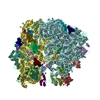

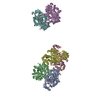
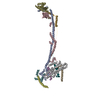
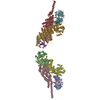
 PDBj
PDBj






























